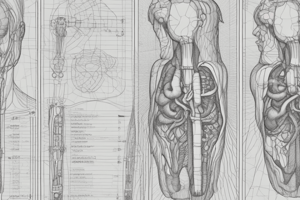Podcast
Questions and Answers
What should be applied on the site after examining the patient's arm to see if bleeding has stopped?
What should be applied on the site after examining the patient's arm to see if bleeding has stopped?
adhesive bandage or tape
How long should the patient leave the bandage on after a venipuncture?
How long should the patient leave the bandage on after a venipuncture?
- 10 minutes
- 5 minutes
- 15 minutes (correct)
- 30 minutes
What should outpatients avoid doing with the arm where the venipuncture was performed for 1 hour?
What should outpatients avoid doing with the arm where the venipuncture was performed for 1 hour?
not carry a purse or other heavy object, not lift heavy objects
Contaminated materials should be disposed of in approved ______ containers following institutional policies before attending to the next patient.
Contaminated materials should be disposed of in approved ______ containers following institutional policies before attending to the next patient.
What information is required on a test requisition form for phlebotomy procedures?
What information is required on a test requisition form for phlebotomy procedures?
What is the function of a tourniquet during a venipuncture procedure?
What is the function of a tourniquet during a venipuncture procedure?
Phlebotomists should always ask patients if they are allergic to latex before starting a procedure.
Phlebotomists should always ask patients if they are allergic to latex before starting a procedure.
The preferred site for venipuncture is the ________ fossa.
The preferred site for venipuncture is the ________ fossa.
Flashcards are hidden until you start studying
Study Notes
Foundation in Venipuncture
- The goal of venipuncture is to ensure safety, patient comfort, and quality.
- The process begins with the receipt of a test requisition form that includes required information such as patient's name, identification number, date of birth, location, ordering healthcare provider, test requested, and date and time of extraction.
Greeting the Patient
- The phlebotomist should greet the patient, introduce themselves, and explain the procedure to the patient.
Patient Identification
- The patient should be identified verbally by having them state their first and last name, and comparing the information with the patient's ID band and the requisition form.
- Correct patient identification is the most important procedure in phlebotomy.
Patient Preparation
- The patient should be positioned conveniently and safely for the procedure.
- The phlebotomist should always ask the patient if they are allergic to latex.
Equipment Selection
- The phlebotomist should collect all necessary supplies and place them close to the patient.
Wash Hands and Apply Gloves
- The phlebotomist should wash their hands and apply gloves according to OSHA regulations.
Tourniquet Application
- The tourniquet should be applied 3-4 inches above the antecubital fossa to impede venous blood flow and make veins more easily located.
- The maximum time for tourniquet application is 1 minute.
- The tourniquet should be applied twice, first during vein selection and second during puncture.
Site of Collection
- The preferred site for venipuncture is the antecubital fossa.
- The median cubital vein is the preferred vein for venipuncture due to its size, stability, and proximity to the surface.
- The cephalic vein is the second choice, and the basilic vein is the last choice due to its proximity to the median nerve and brachial artery.
Palpation
- Palpation is performed using the tip of the index finger to probe the antecubital area with a pushing motion.
- Pressure is applied to locate deep veins, which feel like spongy, resilient tube-like structures.
Cleansing the Site
- The site should be cleansed with 70% isopropyl alcohol using a circular motion, and allowed to dry for 30-60 seconds.
- Povidone-iodine or chlorohexidine gluconate may also be used.
Assembly of Puncture Equipment
- The phlebotomist should check the equipment for defects, ensure the needle and syringe are properly screwed, and have extra tubes nearby.
- The collection tray should not be placed on the patient's bed.
Performing Venipuncture
- The tourniquet should be reapplied before needle insertion.
- The needle should be inserted bevel up, at an angle of 15-30 degrees, and the vein should be anchored using the thumb of the non-dominant hand.
- The needle should be inserted in a smooth motion, and the patient should only feel the stick briefly.
Removing the Needle
- The tourniquet should be released before removing the needle to prevent bruising.
- A folded gauze should be placed over the venipuncture site, and the needle should be withdrawn in a smooth, swift motion.
- Pressure should be applied to the site as soon as the needle is withdrawn.
Disposal of Needle
- The contaminated needle and holder should be disposed of in an acceptable sharps container.
Labeling the Tubes
- The tubes should be labeled after they are drawn and mixed, while the patient is still present, to reduce the risk of specimen misidentification.
- The label should include the patient's name, identification number, date and time of collection, and phlebotomist's initials.
Bandaging the Patient's Arm
- The patient's arm should be bandaged to apply pressure to the venipuncture site, and the bleeding should stop within 5 minutes.
Leaving the Patient
- The patient should be thanked for their cooperation, and the area should be cleaned up before attending to the next patient.
- Outpatients should be instructed not to carry heavy objects or lift with that arm for 1 hour.
Post-Venipuncture
- The patient's arm should be examined to ensure bleeding has stopped, and an adhesive bandage or tape should be applied.
- The patient should be advised not to carry heavy objects or lift with that arm for 1 hour, and should be thanked for their cooperation.
Studying That Suits You
Use AI to generate personalized quizzes and flashcards to suit your learning preferences.




